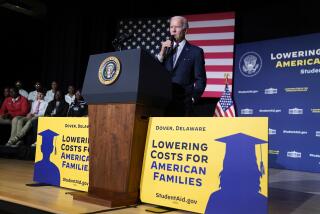How to pay back your college debt, painlessly

Talk about tough timing. Student loan grace periods generally expire for spring graduates just in time for the winter holidays. So, in addition to finding a way to finance holiday spending, recent college graduates need to figure out a college debt repayment plan.
Want a relatively painless college debt repayment plan that won’t hamper your holiday spending? Here’s a step-by-step guide. All it takes is strategy, discipline and a side hustle or two.
Gather debt information
Before you can create a viable plan, you need to assess where you stand. That requires finding all the information on how much you owe, the interest rates on your loans and the type of loans you have. You can get most of this information from the federal government’s student loan information center at StudentAid.gov.
Remember that there are four distinct types of college loans: 1) subsidized federal loans; 2) unsubsidized federal loans; 3) PLUS loans (for parents and professional and graduate students); and 4) private student loans.
Loans in the first three categories are federally guaranteed. They also offer preferential interest rates and repayment terms. Private loans, on the other hand, frequently have variable interest rates and less-favorable repayment terms. In inflationary environments like this one, the cost of private loans with variable interest rates can rise rapidly. That makes it smart to prioritize repaying those private loans as quickly as you can.
College debt repayment plan
The short version of our repayment plan: Get a side hustle to earn extra cash that you can apply to your loans. Pay off one loan at a time, focusing on the highest-risk and highest-rate debts first. When you repay the first loan, “snowball” your next payment by adding the amount you would have applied to the now-eliminated loan. Repeat until all the loans are gone. This rapidly erases your debts and saves a fortune in interest.
But this is easier to explain with an example.
Categorize by loan type and interest rate
Let’s say that you have $40,000 in total debt, equally divided among subsidized, unsubsidized, PLUS and private debts. According to StudentAid.gov, the current interest rate on subsidized loans is 3.73%; unsubsidized loans are at 5.28% and PLUS loans are at 6.28%. Private loan rates range from 3% to more than 14%, according to NerdWallet. For the sake of this example, we’ll say that your private loan is currently at a 5% interest rate. But it’s a variable-rate debt that can be adjusted annually.
Based on standard 10-year college debt repayment plan terms, your starting repayment amount on the private loan is $106 per month. Your monthly payment amount on the subsidized federal loan is $100. The monthly payment on the unsubsidized federal loan is $107. And your monthly payment on the PLUS loan is $112. Altogether, your mandatory student loan payments amount to $425 per month.
Side hustle to create a repayment snowball
If you stick to the regular program, it will take 10 years — 120 months — to repay your college loans. And you’ll pay more than $11,000 in interest on the $40,000 you borrowed.
But if you could find a side hustle that pays just $25 each workday — that’s 22 days a month — you’d have an extra $550 per month to apply to those loans. Do that and you’re debt-free in four years.
The math
A little bit of math helps illustrate the advantage of this plan.
Let’s say you want to pay off the private loan first to avoid any rate hikes that might be coming due to the variable rate. So you add the $550 that you earn from your side hustle to the regular monthly payment that’s due on that loan. Thus, instead of paying $106 monthly on the private loan, you pay $656. This payment will repay this loan in 16 months at a total cost of $10,353, according to Mint’s Loan Repayment Calculator.
Once you no longer have to pay on that private loan, you can apply the $656 to your next highest-cost debt — the PLUS loan. Now, instead of paying just $112 per month on this loan, you are slamming $768 a month against that debt. You would still owe almost $9,000 on that debt when your private loan is paid off. But by applying the growing “snowball” payment to that loan, the PLUS loan is paid off in just 13 more months.
Now add the $768 payment snowball to your $107 unsubsidized loan payment, applying $875 per month against that loan. In nine months, that loan’s $8,042 balance is paid off too. Your final loan — the subsidized federal loan at 3.74% interest — has a $100 minimum payment and a $7,222 balance some 38 months into the 120-month standard loan term. You now add the $875 snowball payment to your $100 loan payment. And your final loan is repaid eight months later.
You’ve repaid all of your loans in 46 months — 74 months ahead of schedule. And you’ve saved more than $7,000 in interest, paying just $3,971 in interest charges over the four years you were in debt, instead of more than $11,000.
Side hustle options
But is it realistic to imagine that you could earn $550 per month with a side hustle, without having a nervous breakdown? If you’re willing to add about one hour to your workday, it’s not only possible, it could be easy. A few options:
Rover enlists freelancers to walk dogs. You set your own rates, paying a commission to the platform for finding clients and collecting payment. The typical dog walker charges $20 per half-hour walk. If you walk a dog for a half-hour on your lunch break and another before dinner, you’ve earned $40, and gotten a little exercise. After paying site fees, you pocket $32 daily.
Like dogs, but don’t want to walk? If you don’t mind watching dogs overnight, you can earn $25 to $55 a day dog-sitting in your house or the client’s.
Other options
Since you’ve completed college, you also have access to all sorts of tutoring jobs that pay between $15 and $50 per hour, depending on the subject and whether the session is in person or online.
Or: If applying for jobs after college made you expert at crafting a great resume, you can advertise your resume-writing services on Fiverr. You decide whether to offer simple proofreading or premium packages that might include formatting and rewriting. You also determine how much to charge.
In fact, Fiverr allows freelancers to offer a wide array of mostly remote services on the platform. These services include voice-over acting, illustrations, graphic design, editing, translation, web design — you name it. You decide what you want to do and how much you want to charge. Fiverr takes a 20% commission for helping you find clients and collecting payment.
Want to shop for others or provide some other in-person service? TaskRabbit allows you to list and price your own service, such as grocery shopping, furniture assembly or moving.
Don’t want to work every day? Consider driving for Lyft and Uber on the weekends, when demand is highest. Although you must pay for your own car maintenance and gas, drivers maintain that they can easily earn $200 per day and, often, considerably more.
Kristof is the editor of SideHusl.com, an independent website that reviews moneymaking opportunities in the gig economy.
More to Read
Inside the business of entertainment
The Wide Shot brings you news, analysis and insights on everything from streaming wars to production — and what it all means for the future.
You may occasionally receive promotional content from the Los Angeles Times.










